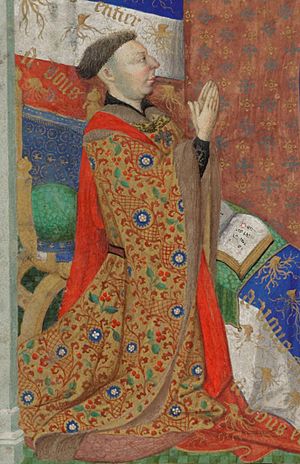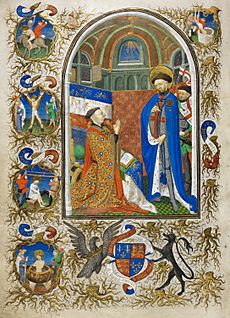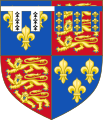John of Lancaster, Duke of Bedford facts for kids
Quick facts for kids John of Lancaster |
|
|---|---|
| Duke of Bedford Regent of France |
|

The Duke of Bedford with his heraldic badge of "wood stocks" (tree-stumps) and his motto A Vous Entier
(miniature from Bedford Hours) |
|
| Born | 20 June 1389 |
| Died | 14 September 1435 (aged 46) Castle of Joyeux Repos, Rouen, Normandy |
| Burial | 30 September 1435 Rouen Cathedral, Rouen |
| Spouse |
|
| House | Lancaster |
| Father | Henry IV of England |
| Mother | Mary de Bohun |
| Military service | |
| Allegiance | Kingdom of England |
| Conflicts | Anglo-Scottish border wars Hundred Years' War |

John of Lancaster, Duke of Bedford (born June 20, 1389 – died September 14, 1435) was an important English prince, general, and leader. He led England's armies in France during a key part of the Hundred Years' War. John was the third son of King Henry IV of England and the brother of Henry V. He also served as the regent of France for his young nephew, Henry VI.
John was a skilled leader and soldier. His good management of the war helped England reach its strongest point in France. However, things became harder after Joan of Arc appeared. His efforts were also made difficult by arguments within England and by their main ally, Duke Philip of Burgundy, who started to change his mind about supporting England. In John's last years, the war became very long and costly. He found it harder to get enough money to keep fighting.
John died in 1435, just as Burgundy was about to leave the English side. Burgundy then made a separate peace agreement with Charles VII of France.
Contents
Early Life and Family
John of Lancaster was born on June 20, 1389. His parents were Henry Bolingbroke (who later became Henry IV of England, King of England) and his wife, Mary de Bohun. John was also the grandson of John of Gaunt, Duke of Lancaster, who was a son of King Edward III.
In 1399, John's father, Henry Bolingbroke, was sent away from England by his cousin, Richard II. This happened after Henry's father had been part of a rebellion. When John of Gaunt died, King Richard II did not let Henry Bolingbroke inherit his father's lands. That same year, Henry Bolingbroke returned to England. With help from many nobles, he gathered supporters and removed Richard II from the throne. Richard II later died. Henry Bolingbroke was crowned King of England as Henry IV on October 13, 1399.
John's oldest brother was Henry of Monmouth, who later became King Henry V. John's other brothers and sisters were Thomas of Lancaster, Duke of Clarence; Humphrey, Duke of Gloucester; Philippa; and Blanche.
Titles and Knighthood
After his father became King Henry IV in 1399, John started to gain important lands and jobs. He was made a knight on October 12, 1399, at his father's coronation. He also became a Knight of the Garter in 1400.
He was given the job of master of the mews (where falcons were kept) in 1402. He became Constable of England in 1403. From 1403 to 1414, he was the Warden of the East March, which meant he protected the border with Scotland. In 1414, his brother, King Henry V, made him Earl of Kendal, Earl of Richmond, and Duke of Bedford.
Protecting the Scottish Border
John gained his first experience in warfare as the warden of the east marches of Scotland, starting in 1404. He was quite successful in this role. By mid-1404, he was not being paid enough, and his soldiers were unhappy. He was in a difficult area and constantly fighting. With the little money he received, John borrowed more and used income from other lands to keep his forces going.
In 1405, he helped stop a rebellion. He also worked with the Earl of Westmorland, who was warden of the west marches. John continued to hold his command in the north until September 1414. He helped strengthen Berwick and tried to keep peace along the border.
Leading English Armies in France
In May 1413, John's brother, now King Henry V, made him Duke of Bedford. After leaving his border job, John began to play a major role in the king's plans. He acted as the king's representative in England when Henry V went to France in 1415. In August 1416, John led the ships that defeated the French fleet at the mouth of the Seine River. This helped relieve the city of Harfleur.
Again, in July 1417, he was made the king's representative. He marched against the Scots, who then stopped their attack on Berwick. When he returned to London, he brought Sir John Oldcastle to trial and was present at his execution. He managed the country well until December 1419, when he joined the king in France. He returned to England in June 1421 and took on the role of king's representative for a third time. In May 1422, he took the queen to join Henry in Normandy, France. He then led the English troops to help the city of Cosne. However, when he heard that the king was very ill, he left the army to be with him.
Becoming Regent
Before he died, King Henry V wished that John of Lancaster would look after the kingdom and the young King Henry VI. He also wanted Philip the Good, Duke of Burgundy, to be the regent (a ruler acting for a king who is too young or unable to rule) in France. But Philip refused this job. So, John of Lancaster took on the role of regent in France as well. After the French King Charles VI died in October 1422, John led a meeting in Paris. He made everyone there promise loyalty to King Henry VI of England.
Meanwhile, the English parliament decided that John should be the Lord Protector of England. If he was away, his brother Humphrey, Duke of Gloucester would take over. John focused on leading the war in France. He continued Henry V's goal of conquering more areas, capturing places like Meulan. He also tried to make his position stronger by forming an alliance with Philip of Burgundy. This was made harder because John's brother, Gloucester, had married Jacqueline, Countess of Holland. This marriage gave Gloucester a claim to lands that Philip wanted for himself. However, John managed to calm Philip's anger. He formed an alliance with Philip and with John VI, Duke of Brittany, in Amiens in April 1423. John himself then married Anne of Burgundy, who was Philip's sister.
War in France
John worked to bring back wealth to the areas he ruled. He improved the money system, gave special rights to traders and makers, and fixed many problems. He also gave some lands to Philip to help stop the growing tension between Philip and John's brother, Gloucester. On August 17, 1424, John won a great victory against a combined French and Scottish army at the Battle of Verneuil.
However, the good relationship between England and Burgundy was partly broken when Gloucester attacked Hainaut in October 1424. His brother's actions caused John more trouble. When Gloucester returned from Hainaut, he argued with the chancellor, Henry Beaufort, Bishop of Winchester. The council asked John to come to England to solve this problem. He arrived in London in January 1426. After making an agreement with Gloucester, he helped Gloucester and the chancellor make peace. He also knighted the young King Henry VI.
John then promised to follow the council's decisions. He raised troops and returned to France in March 1427. He told Gloucester to stop attacking Hainaut. He also threatened Brittany and made Duke John return to the English alliance. The English troops continued to be successful until the Siege of Orleans. John agreed to this siege with some hesitation in October 1428.
When he realized that Philip of Burgundy was ready to leave his side, John ordered his army to stop the siege in April 1429. He then acted with great energy to stop the series of defeats that followed this failure. He strengthened his control over Paris and asked England for more soldiers. Before any big battle, he visited Rouen to try and make the people of Normandy more loyal to England. After returning to Paris, he gave up his role as regent of France to Philip of Burgundy, as the people of Paris wished.
John was the Governor in Normandy between 1422 and 1432. During this time, the University of Caen was started under his guidance. He was also an important person who ordered illuminated manuscripts (beautifully decorated books). The three most important books that still exist from his collection are the Bedford Hours, the Salisbury Breviary (both made in Paris), and the Bedford Psalter and Hours (made in England around 1420–1423).
Keeping his role as governor of Normandy, John lived in Rouen. He guided the English forces with some success. He did not get involved to save the life of Joan of Arc. After Joan was captured by Burgundian troops and given to the English, John had her put on trial by church leaders. She was executed in Rouen on May 30, 1431.
King Henry VI joined John in April 1430, and John arranged for Henry's coronation in Paris in December 1431. In November 1432, John's wife Anne died. In April 1433, he married Jacquetta of Luxembourg in Thérouanne.
John then asked for an investigation into the country's money matters. When parliament asked him to stay in England, he said he would always serve the king. As a chief advisor, he offered to take a smaller salary than his brother Gloucester had received. He took on this job in December 1433. John, who wanted to continue the war in France, left England again in 1434. However, in early 1435, he had to agree that English representatives would attend a meeting to discuss peace terms. The English representatives left in September because they could not agree to France's terms. Philip of Burgundy then made a separate peace treaty with France.
Richard of Bedford
John of Lancaster, Duke of Bedford, had a son named Richard. Richard was known as Richard Bastard of Bedford, which was a common way to refer to the sons of noblemen born outside of marriage in France and England. Richard was likely born before John married in 1423.
Richard's cousin, Henry VI of England, made Richard a legitimate (official) son on August 30, 1434. This was recorded in Rouen, France, on September 27, 1435. After this, Richard was allowed to inherit property in England and France. Richard was supposed to inherit the lordship of La Haye-du-Puits, France, and its castle after his father's death in 1435. However, this inheritance was later changed.
Marriages
John's first wife was Anne of Burgundy (who died in 1432). She was the daughter of John the Fearless. They married on May 13, 1423, in Troyes. They had a happy marriage, but they did not have any children. Anne died from the plague in Paris in 1432.
Louis of Luxembourg, a bishop, arranged a marriage between his niece, Jacquetta of Luxembourg, and John. Jacquetta was the daughter of Peter I, Count of Saint-Pol. This was a smart move because the House of Luxembourg was very rich and powerful. The bishop performed the marriage in Therouanne on April 20, 1433. The new duchess was only seventeen years old. This marriage also did not produce any children. Jacquetta later had more than a dozen children in her second marriage to Richard Woodville. Her oldest child, Elizabeth Woodville, became queen consort of England when she married Edward IV.
Death and Legacy
John died in Rouen on September 14, 1435. He was buried in the main part of Cathedral of Notre-Dame de Rouen. In his will, made four days before his death, he left all his belongings to his wife, except for one castle, which was to go to his son Richard. His nephew, Henry VI, was to receive everything else.
John was a very capable leader. He was brave and fair in war, and wise and selfless in times of peace. He was not to blame for England's problems in France. His courage when facing difficulties was admirable, as was his constant effort to make the people under his rule happy and successful.
In Books and Plays
John of Lancaster appears in William Shakespeare's plays Henry IV, Part 1 and Henry IV, Part 2 as John of Lancaster. He is also in Henry V and Henry VI, Part 1 as the Duke of Bedford. In Henry IV, Part 1, he is shown at the Battle of Shrewsbury in 1403, even though he was only 14 at the time and historical records don't mention him there.
Georgette Heyer's novel My Lord John is the first part of a series that was never finished. It focuses on John's life from age four to about twenty. Brenda Honeyman's novel Brother Bedford covers his life from Henry V's death until his own death.
In the 2011 novel The Lady of the Rivers by Philippa Gregory, John has a small role as the first husband of the main character, Jacquetta of Luxembourg.
Coat of Arms
As a son of the king, John used the royal coat of arms of his father, King Henry IV. His arms were slightly different, with a special design called a label of five points per pale ermine and France. These arms are shown in the Bedford Book of Hours.
Images for kids
-
Arms of John of Lancaster, Duke of Bedford: The Royal arms of England with a special design
See also
 In Spanish: Juan de Lancaster para niños
In Spanish: Juan de Lancaster para niños



